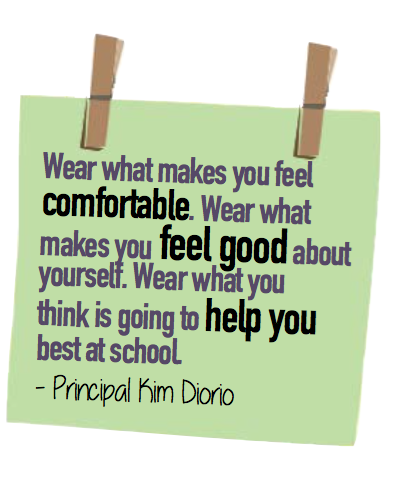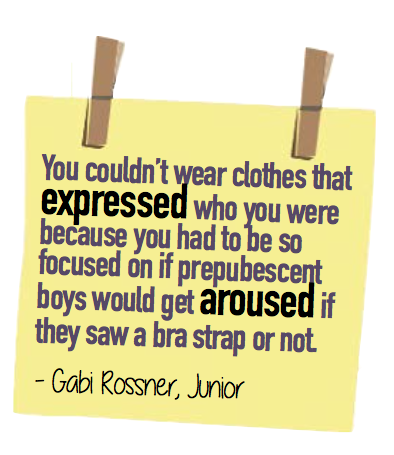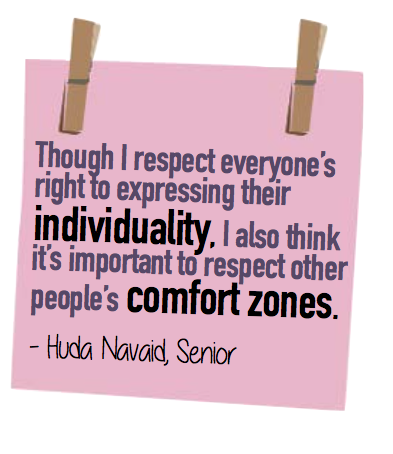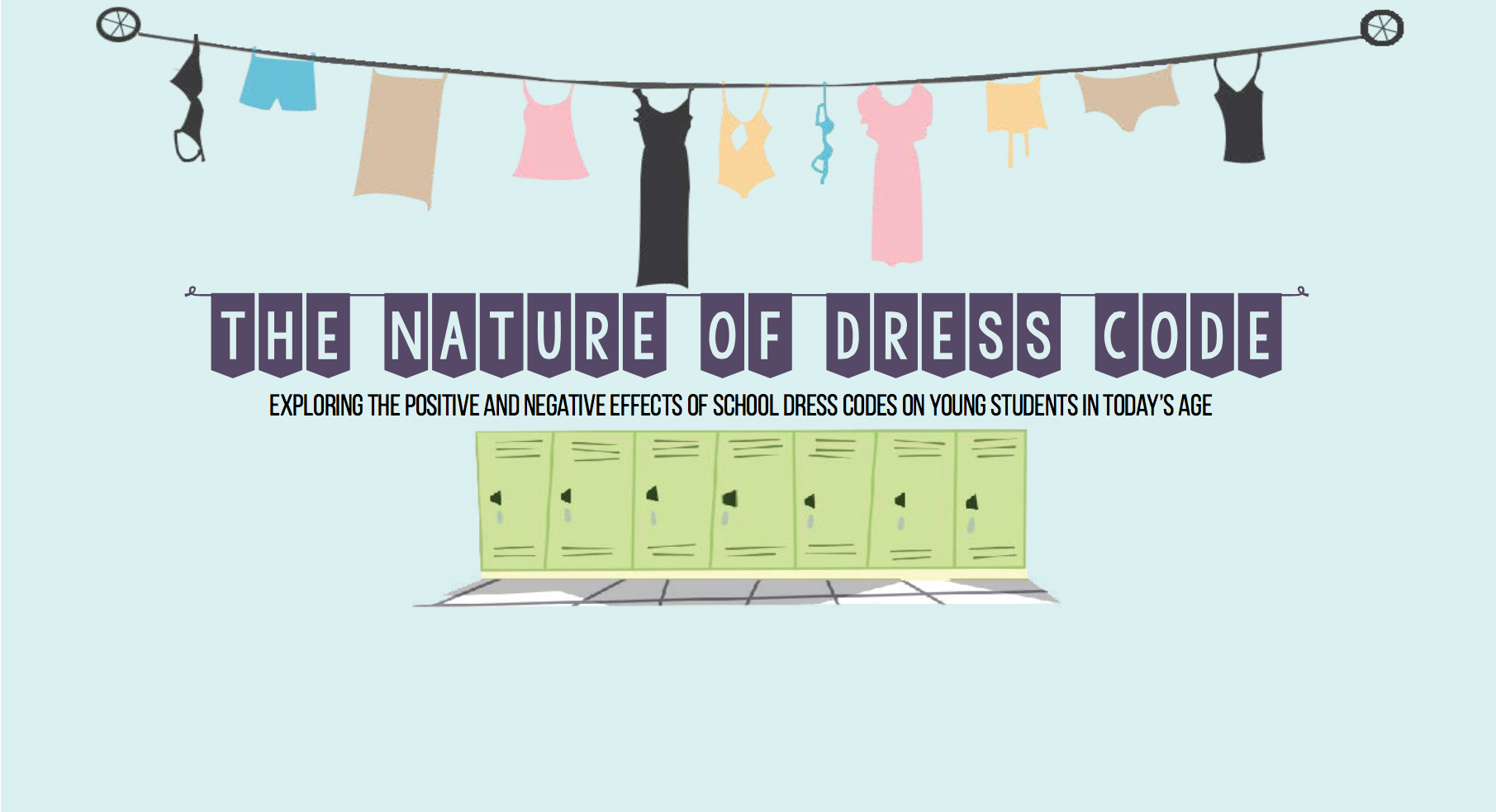Your donation will support the student journalists of Palo Alto High School's newspaper
The nature of the dress code
Exploring the positive and the negative effects of school dress codes on young students in today's age.
September 22, 2014
Thoughout history and across regions, there have almost always been limitations on what women and men can wear, especially in professional environments. In academic institutions, such rules are packaged in the form of what is commonly called a dress code. In recent years, dress code has become a serious topic of conversation, producing notable perspectives from both those who support outfit guidelines and those who strongly oppose it.
From Orange Park. Fla., to our own Palo Alto, people have been calling into question the validity of certain aspects of the dress code. Recently, in the wake of the new school year, sophomore Miranda Larkin of Oakleaf High School in Orange Park, Fla., became one of many students affected by schools’ dress codes. On her third day of school, Larkin was dress coded by her school administration for wearing a skirt that was deemed to be too short. Larkin was punished with a dress code violation outfit, which consisted of a neon yellow shirt reading “DRESS CODE VIOLATION,” along with sweatpants that contained the same text.
“The school has said [that the dress code punishment] is [used] to embarrass you,” Larkin said to ABC News. “It’s supposed to embarrass you so you don’t do it again.”
Occurrences like these have caused controversy and debate throughout the nation over whether dress codes should be implemented in schools, and this trend has recently spread to Jordan Middle School. Revisions in Jordan’s dress code have become a prevalent subject of discussion, and while most people think that the dress code has valuable aspects, other facets of the dress code have raised doubts about the purpose and legitimacy of these limitations set by Jordan.
According to Jordan Middle School principal Gregory Barnes, Jordan’s new dress code rules concerning yoga pants increased and tightened with the recent increase in popularity of yoga pants.
“The current rule is that if your yoga pants are deemed to be see-through, you need to cover up,” Barnes said. “That could mean a long shirt, or it could mean that you could change into your PE shorts.”
Jordan is one of many schools that has a dress code constituting what students may wear, having rules like “shorts and skirts mus
reach below the length of the fingertips” and “straps on shirts must be at least 1-inch wide.” Although Jordan does have these rules that limit girls’ clothing choices, many other schools across the country push even greater restraints and limitations on their students, banning some clothing, such as yoga pants, entirely.
According to Jordan, “it is expected that students dress in a style that is conducive to learning.” In other terms, the dress code is used to prevent students from distracting other students.
 “The point of the dress code is to make sure that you are wearing the appropriate clothes for your environment,” Jordan Middle School principal Gregory Barnes said. “As adults would say, [the clothes which] are ‘distraction free.’”
“The point of the dress code is to make sure that you are wearing the appropriate clothes for your environment,” Jordan Middle School principal Gregory Barnes said. “As adults would say, [the clothes which] are ‘distraction free.’”
While the dress code is not gender specific, rules like “shorts/skirts must reach below the length of the fingertips” and “pants must fit appropriately meaning that there should be no panty lines, [meaning that] they should not stretch across the skin where the fabric is taut and pulled,” generally speaking, are applied to the female side of populations, due to trends for young women. Many students have noticed this gender bias.
“The dress code is all about girls,” sophomore Victor Carlsson said. “The only thing it says about guys is to not sag.”
Barnes accounts the disparity between the amount of rules for women and the amount of rules for men as being a result of recent fashion trends.
“Girls and boys adhere to the same length of short policy,” Barnes said. “For the length of shorts, it applies more to girls fashion nowadays than it ever did for mens’ fashion; there’s not a big concern for short shorts for guys.”
However, junior Elana Rebitzer believes that the multitude of rules for girls compared to the small amount of rules for boys shows that the dress code is used to police and limit girls much more than it does for boys.
“[The dress code] supposes that boys are unable to control themselves when they see girls who aren’t as clothed because they are so attracted to the girls, but there is no equivalent dress code rules that prevent guys from wearing sleeveless t-shirts that show their muscles or other parts of their body that could distract girls,” Rebitzer said.
Supporters of the dress code believe that dress codes keep the school environment comfortable for all cultures. Senior Huda Navaid feels that being flashy and showing one’s body is not necessarily suitable or appropriate for the school environment.
“Though I respect everyone’s right to expressing their individuality, I also think it’s important to respect other people’s comfort zones,” Navaid said. “Especially at school. For this reason, I think it’s important to uphold a dress code just because school should be a place where everyone feels comfortable.
At public schools especially, where there exists a wide variety of different cultural and ethnic backgrounds, supporters of dress code, like Navaid, believe that these dress codes allow people of all different values and traditions to find an intermediate that allows all students, no matter what their individual cultures may be, to feel comfortable at school.
However, opponents of the dress code believe that by sexualizing just women’s bodies, schools are also suggesting that boys cannot control themselves from distraction and thus cope with this by forcing girls to change themselves and their clothing to compensate for boys’ uncontrollable thoughts.
Senior Phoenix Jarrell-Desch agrees with this and suggests that schools should focus on teaching boys to view girls and the way they dress in a better light instead of solely blaming women for what men think.
“You need to teach boys to pay attention in class instead of teaching girls to cover themselves up from boys who can’t control themselves,” Jarrell-Desch said.
Junior Gabi Rossner believes that the dress code’s strong limitations on women’s clothing propagates the stereotype that men are overly and unmanageably distracted by women’s bodies to the point at which they cannot control their thoughts and actions.
“Dress codes paint boys to be uncontrollable sex maniacs, which is very harmful to men,” Rossner said. “It creates these binds and gender stereotypes and this burden of masculinity.”
Firm believers against dress code, such as Rossner, believe that because society forms the stereotype that boys are full of uncontrollable hormones and are instinctive sexual animals, the dress code faults girls and essentially forces them to change themselves for the thoughts of boys. As well, many students believe that dress code rules associated with girls’ clothing choices teach men to look at women in a sexual and objective way, which often is one of many root issues that grow into larger rape culture concepts.
 Palo Alto High School principal Kim Diorio worries that dress codes teach young girls negative and dangerous connotations about their bodies.
Palo Alto High School principal Kim Diorio worries that dress codes teach young girls negative and dangerous connotations about their bodies.
“[The idea of dress code] goes back to the whole conversation of rape culture and the mindset that it’s easy for people to find that if a girls dresses provocatively or if a girl behaves in a way thats seductive that she’s passively giving consent based on her appearance or her behavior,” Diorio said.
Similarly to Diorio, Rossner believes that the dress code brings about the stereotype that women’s bodies are innately sexual and are constantly attracting the attention of boys.
“The [dress code was used] to make sure boys weren’t distracted and to make sure girls weren’t hyper sexualized, which I think is double-bind,” Rossner said. “When you say a 13 year old girl is being sexy when wearing those clothes, that is sexualizing a 13 year old. When in reality, she’s wearing those clothes because she thinks she looks good and because it’s hot outside.”
Rebitzer also believes that schools and dress codes unproportionally and unfairly target girls for what they wear.
“Does it really make sense to be telling teenage girls that because they are girls, they will automatically be objectified?” Rebitzer said. “That they are only allowed to use their bodies in ways that won’t distract the boys? Does anybody ever tell the boys don’t get distracted? No.”
Rebitzer has felt the lasting and harmful effects of the dress code and believes that by punishing girls who do dress more provocatively or who do show more skin, schools in turn teach girls that exposing their bodies is shameful.
“I think the most important thing is that these are girls who are 11 to 14 years old, which are really formative years in a girl’s life.” Rebitze said. “Making teenage girls feel like their bodies aren’t even theirs is something that’s likely to lead to eating disorders or dysphoria. As a high schooler, with no dress code, I sometimes try on clothes that I know look good on me and accentuate parts of my body which I don’t mind showing, but I feel uncomfortable wearing them because I know they don’t fit the middle school rules of the dress code that we were taught for three years and forced to respect.”
Rebitzer’s experience with her school’s dress code is not a stand-alone occurrence; many young students have experienced similar senses of shame and disgrace because of their school’s dress codes, such as Larkin and Rossner.
“In middle school [the dress code] taught me to be ashamed of my body,” Rossner said. “[The dress code taught me to be] angry and ashamed because you couldn’t wear clothes that expressed who you were because you had to be so focused on if prepubescent boys would get aroused if they saw a bra strap or not. There was one time in 7th grade where I was wearing a tight t-shirt that covered my body. I was told it was ‘too tight’ and that my boobs were ‘too big’, and I had to go change into a baggy PE shirt.”
Although some girls have not experienced being dress coded, the majority of students have witnessed some violation of the dress code and have seen the shame that it brings to people, including Jordan eighth grader Ellie Krugler.
“Some teachers dress code people who are really wearing what everyone else is wearing,” Krugler said. “One girl got dress coded for wearing athletic shorts, and it’s a really embarrassing thing when you get dress coded.”
“Dress codes teach girls to be ashamed of their bodies and other to shame them for wearing clothes that they like,” Rossner said. “T here is no motivation behind [those punishments that publicly shame girls] other than to make girls feel bad. That’s wrong.”
here is no motivation behind [those punishments that publicly shame girls] other than to make girls feel bad. That’s wrong.”
While opponents believe that these dress codes should not focus on sexualizing women and shaming them as a punishment, many students believe that the dress code has some facts that are valid. Rebitzer believes that prohibiting illegal or dangerous activities such as the consuming of drugs and alcohol or the promotion of gangs has value and significance, as these activities pose realistic and actual threats towards young children, unlike prohibiting clothing because it may be distracting to others.
“In a school environment, it makes sense that schools and administrators want to lay certain limits on what they find appropriate,” Rebitzer said. “Drugs and alcohol, for example, are completely illegal for middle schoolers to partake in. So it makes sense that school teachers want to limit that exposure.”
Navaid also believes limits made by the dress code keeps a standard that should make everyone feel safe at school.
“While I believe that everyone should be able to express themselves, in a school environment, I feel as though the line has to be drawn somewhere at some point,” Navaid said. “If there were no lines drawn, things could get out of hand.”
Although schools put these limitations on their students, Diorio still feels that it is important that girls and boys have a conversation with their parents about what is appropriate to wear in his or her own household instead of looking towards the dress code as a guideline for what to wear.
“I think that people come with very different cultural backgrounds and religious backgrounds that we can’t assume everyone agrees with or disagrees with it,” Diorio said. “I hope that when my daughters are in middle school, we can have a discussion as a family, and we can talk about what’s more appropriate for school versus what’s more appropriate when you’re going to a dance or hanging out with your friends outside of school.”
Navaid mirrors Diorio’s belief that students should dress accordingly to their cultural and religious beliefs.
“I wear a headscarf and I know that it can often be too much for some people,” Navaid said. “I would never, however, enforce wearing long clothes and a headscarf on anyone. It’s a personal choice for myself.”
Jordan dress code and dress codes all around the country set limitations on what students can wear, and the effect that it has on an individual widely varies both across regions and within schools. While some believe that the dress code is beneficial because it teaches youth what is appropriate to wear at school, others have felt shamed and humiliated by the dress code and believe that the dress code propagates several gender biases. With this ongoing debate of whether dress codes should continue in schools and what limitations are acceptable to push onto students, schools need to find a median between the two extremes. There are various ways to accomplish this middle ground, and different schools across the nation will have different limitations and rules depending on its community and its environment.
For Palo Alto, Diorio believes that the best option is to allow students and their parents to independently choose the clothing that makes them feel best in a school environment.
“Wear what makes you feel comfortable,” Diorio said. “Wear what makes you feel good about yourself. Wear what you think is going to help you best at school.”
